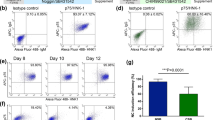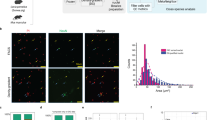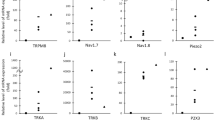Abstract
Primary cultures of rodent sensory neurons are widely used to investigate the cellular and molecular mechanisms involved in pain, itch, nerve injury and regeneration. However, translation of these preclinical findings may be greatly improved by direct validation in human tissues. We have developed an approach to extract and culture human sensory neurons in collaboration with a local organ procurement organization (OPO). Here we describe the surgical procedure for extraction of human dorsal root ganglia (hDRG) and the necessary modifications to existing culture techniques to prepare viable adult human sensory neurons for functional studies. Dissociated sensory neurons can be maintained in culture for >10 d, and they are amenable to electrophysiological recording, calcium imaging and viral gene transfer. The entire process of extraction and culturing can be completed in <7 h, and it can be performed by trained graduate students. This approach can be applied at any institution with access to organ donors consenting to tissue donation for research, and is an invaluable resource for improving translational research.
This is a preview of subscription content, access via your institution
Access options
Subscribe to this journal
Receive 12 print issues and online access
$259.00 per year
only $21.58 per issue
Buy this article
- Purchase on Springer Link
- Instant access to full article PDF
Prices may be subject to local taxes which are calculated during checkout







Similar content being viewed by others
References
Lacroix-Fralish, M.L., Ledoux, J.B. & Mogil, J.S. The pain genes database: an interactive web browser of pain-related transgenic knockout studies. Pain 131, 3.e1-4 (2007).
Chizh, B.A. et al. The effects of the TRPV1 antagonist SB-705498 on TRPV1 receptor-mediated activity and inflammatory hyperalgesia in humans. Pain 132, 132–141 (2007).
Kivitz, A.J. et al. Efficacy and safety of tanezumab versus naproxen in the treatment of chronic low back pain. Pain 154, 1009–1021 (2013).
Skljarevski, V. et al. Efficacy of duloxetine in patients with chronic pain conditions. Current Drug Ther. 6, 296–303 (2011).
Wernicke, J.F. et al. A randomized controlled trial of duloxetine in diabetic peripheral neuropathic pain. Neurology 67, 1411–1420 (2006).
Hill, R. NK1 (substance P) receptor antagonists–why are they not analgesic in humans? Trends in Pharmacol. Sci. 21, 244–246 (2000).
Taneja, A., Di Iorio, V.L., Danhof, M. & Della Pasqua, O. Translation of drug effects from experimental models of neuropathic pain and analgesia to humans. Drug Discov. Today 17, 837–849 (2012).
Mogil, J.S. Animal models of pain: progress and challenges. Nat. Rev. Neurosci. 10, 283–294 (2009).
Contopoulos-Ioannidis, D.G., Ntzani, E. & Ioannidis, J.P. Translation of highly promising basic science research into clinical applications. Am. J. Med. 114, 477–484 (2003).
Ergorul, C. & Levin, L.A. Solving the lost in translation problem: improving the effectiveness of translational research. Curr. Opin. Pharmacol. 13, 108–114 (2013).
Hug, A. & Weidner, N. From bench to beside to cure spinal cord injury: lost in translation? Int. Rev. Neurobiol. 106, 173–196 (2012).
Gereau, R.W. et al. A pain research agenda for the 21st century. J. Pain 15, 1203–1214 (2014).
Han, L. et al. A subpopulation of nociceptors specifically linked to itch. Nat. Neurosci. 16, 174–182 (2012).
Liu, Q. et al. The distinct roles of two GPCRs, MrgprC11 and PAR2, in itch and hyperalgesia. Sci. Signal. 4, ra45 (2011).
Liu, Q. et al. Sensory neuron-specific GPCR Mrgprs are itch receptors mediating chloroquine-induced pruritus. Cell 139, 1353–1365 (2009).
Solinski, H.J., Gudermann, T. & Breit, A. Pharmacology and signaling of MAS-related G protein-coupled receptors. Pharmacol. Rev. 66, 570–597 (2014).
Solinski, H.J., Zierler, S., Gudermann, T. & Breit, A. Human sensory neuron-specific Mas-related G protein-coupled receptors-X1 sensitize and directly activate transient receptor potential cation channel V1 via distinct signaling pathways. J. Biol. Chem. 287, 40956–40971 (2012).
Zhang, X.L., Lee, K.Y., Priest, B.T., Belfer, I. & Gold, M.S. Inflammatory mediator-induced modulation of GABA currents in human sensory neurons. Neuroscience 310, 401–409 (2015).
Li, Y. et al. The cancer chemotherapeutic paclitaxel increases human and rodent sensory neuron responses to TRPV1 by activation of TLR4. J. Neurosci. 35, 13487–13500 (2015).
Anand, U. et al. Angiotensin II type 2 receptor (AT2 R) localization and antagonist-mediated inhibition of capsaicin responses and neurite outgrowth in human and rat sensory neurons. Eur. J. Pain 17, 1012–1026 (2013).
Davidson, S. et al. Human sensory neurons: membrane properties and sensitization by inflammatory mediators. Pain 155, 1861–1870 (2014).
Davidson, S. et al. Group II mGluRs suppress hyperexcitability in mouse and human nociceptors. Pain doi:10.1097/j.pain.0000000000000621, published online (21 May 2016).
Iyer, S.M. et al. Virally mediated optogenetic excitation and inhibition of pain in freely moving nontransgenic mice. Nat. Biotechnol. 32, 274–278 (2014).
Park, S.I. et al. Soft, stretchable, fully implantable miniaturized optoelectronic systems for wireless optogenetics. Nat. Biotechnol. 33, 1280–1286 (2015).
Copits, B.A., Pullen, M.Y. & Gereau, R.W. Spotlight on pain: optogenetic approaches for interrogating somatosensory circuits. Pain doi:10.1097/j.pain.0000000000000620 (2016).
Yang, D. & Gereau, R.W. Peripheral group II metabotropic glutamate receptors (mGluR2/3) regulate prostaglandin E2-mediated sensitization of capsaicin responses and thermal nociception. J. Neurosci. 22, 6388–6393 (2002).
Hu, H.J., Bhave, G. & Gereau, R.W. Prostaglandin and protein kinase A-dependent modulation of vanilloid receptor function by metabotropic glutamate receptor 5: potential mechanism for thermal hyperalgesia. J. Neurosci. 22, 7444–7452 (2002).
Jin, X. & Gereau, R.W. Acute p38-mediated modulation of tetrodotoxin-resistant sodium channels in mouse sensory neurons by tumor necrosis factor-alpha. J. Neurosci. 26, 246–255 (2006).
Yang, D. & Gereau, R.W. Group II metabotropic glutamate receptors inhibit cAMP-dependent protein kinase-mediated enhancemednt of tetrodotoxin-resistant sodium currents in mouse dorsal root ganglion neurons. Neurosci. Lett. 357, 159–162 (2004).
Valtcheva, M.V., Davidson, S., Zhao, C., Leitges, M. & Gereau, R.W. Protein kinase Cdelta mediates histamine-evoked itch and responses in pruriceptors. Mol. Pain 11, 1 (2015).
Valtcheva, M.V., Samineni, V.K., Golden, J.P., Gereau, R.W. & Davidson, S. Enhanced nonpeptidergic intraepidermal fiber density and an expanded subset of chloroquine-responsive trigeminal neurons in a mouse model of dry skin itch. J. Pain 16, 346–356 (2015).
Sheahan, T.D., Copits, B.A., Golden, J.P. & Gereau, R.W. Voluntary exercise training: analysis of mice in uninjured, inflammatory, and nerve-injured pain states. PLoS One 10, e0133191 (2015).
Blanchard, J.W. et al. Selective conversion of fibroblasts into peripheral sensory neurons. Nat. Neurosci. 18, 25–35 (2015).
Wainger, B.J. et al. Modeling pain in vitro using nociceptor neurons reprogrammed from fibroblasts. Nat. Neurosci. 18, 17–24 (2015).
Zhao, S. et al. Cell type-specific channelrhodopsin-2 transgenic mice for optogenetic dissection of neural circuitry function. Nat. Methods 8, 745–752 (2011).
Ting, J.T., Daigle, T.L., Chen, Q. & Feng, G. Acute brain slice methods for adult and aging animals: application of targeted patch clamp analysis and optogenetics. Methods Mol. Biol. 1183, 221–242 (2014).
Hille, B. The permeability of the sodium channel to organic cations in myelinated nerve. J. Gen. Physiol. 58, 599–619 (1971).
Siuda, E.R. et al. Spatiotemporal control of opioid signaling and behavior. Neuron 86, 923–935 (2015).
Goverdhana, S. et al. Regulatable gene expression systems for gene therapy applications: progress and future challenges. Mol. Ther. 12, 189–211 (2005).
Glorioso, J.C. & Fink, D.J. Herpes vector-mediated gene transfer in the treatment of chronic pain. Mol. Ther. 17, 13–18 (2009).
Hsu, P.D., Lander, E.S. & Zhang, F. Development and applications of CRISPR-Cas9 for genome engineering. Cell 157, 1262–1278 (2014).
Incontro, S., Asensio, C.S., Edwards, R.H. & Nicoll, R.A. Efficient, complete deletion of synaptic proteins using CRISPR. Neuron 83, 1051–1057 (2014).
Bhave, G. et al. Protein kinase C phosphorylation sensitizes but does not activate the capsaicin receptor transient receptor potential vanilloid 1 (TRPV1). Proc. Natl. Acad. Sci. USA 100, 12480–12485 (2003).
Acknowledgements
We thank the donors and their families for their generous donations to science. We thank Mid-America Transplant for providing access to donor tissue and their facilities, and especially P. Silva and J. Lemen for their tremendous help coordinating and performing hDRG extractions. We thank A. Vannucci and Y. Lin for helpful discussions and guidance in establishing the research collaboration with Mid-America Transplant. We thank O. Crisp from the Washington University Pathology Department for demonstrating DRG removal using the autopsy saw. We thank J. Sinn-Hanlon for generating the illustrations in Figure 1. We thank D. Brenner for helpful discussions on the development of extraction procedures. This work was supported by US National Institute of Neurological Disorders and Stroke grants R01NS042595 (R.W.G.), F31NS089130 (M.V.V.), F32NS076324 (S.D.), and T32GM108539 (B.A.C.) and T32GM007067-41 (M.Y.P.) from the US National Institute of General Medical Sciences.
Author information
Authors and Affiliations
Contributions
M.V.V., S.D., B.A.C. and K.D. developed the surgical approach. M.V.V., S.D., B.A.C. and T.D.S. optimized existing rodent culturing protocol to establish viable hDRG cultures. M.V.V., B.A.C., T.D.S., M.Y.P. and J.G.M. contributed to applications including immunocytochemistry, calcium imaging, electrophysiology and optogenetic experiments. All authors contributed to writing and editing the manuscript.
Corresponding author
Ethics declarations
Competing interests
The authors declare no competing financial interests.
Rights and permissions
About this article
Cite this article
Valtcheva, M., Copits, B., Davidson, S. et al. Surgical extraction of human dorsal root ganglia from organ donors and preparation of primary sensory neuron cultures. Nat Protoc 11, 1877–1888 (2016). https://doi.org/10.1038/nprot.2016.111
Published:
Issue Date:
DOI: https://doi.org/10.1038/nprot.2016.111
This article is cited by
-
Electric Field Stimulation for the Functional Assessment of Isolated Dorsal Root Ganglion Neuron Excitability
Annals of Biomedical Engineering (2021)
-
A video protocol for rapid dissection of mouse dorsal root ganglia from defined spinal levels
BMC Research Notes (2020)
-
Robust induction of neural crest cells to derive peripheral sensory neurons from human induced pluripotent stem cells
Scientific Reports (2020)
-
A wireless closed-loop system for optogenetic peripheral neuromodulation
Nature (2019)
Comments
By submitting a comment you agree to abide by our Terms and Community Guidelines. If you find something abusive or that does not comply with our terms or guidelines please flag it as inappropriate.



